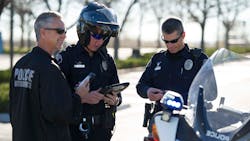New Broadband Technology Gives Officers More Ways to Connect
Sponsored by Harris Corporation.
Broadband technology unlocks a whole new world for first responders, allowing those at the patrol level the ability to send and receive information faster and more reliably.
Public safety professionals, from fire and EMS to all manner of law enforcement agencies, are always looking for better ways to keep connected at all times. While advancements in technology can now connect officers with vast amounts of information, the growing challenge is less about if information can be communicated, and more about how to best to provide information that is timely, relevant and actionable.
Technology at the patrol level
Fast-forward to today and there still remains a critical need to receive more information and increase situational awareness for first responders. "Information is moving quickly and first responders must be able to process that information as fast as possible to save lives and keep people safe," says Johnson. The days of sending only voice or not being able to communicate with first responders providing mutual aid is coming to an end. Johnson says Sept. 11, 2001 changed the way many first responders thought about their communications. "On the 10th year anniversary of 9/11, the Chief of Police of the NYPD said the one thing that could have been better on that terrible day was communications," says Johnson. "Agencies came to provide mutual aid but weren’t on the same radio channels and didn’t have the ability to communicate with other responders on-scene. Compounding this problem were the large number of users trying to use a limited number of networks, and cellular was not an option."
To address this critical issue, Harris Corporation has expanded technology to the patrol level to create a connected experience for law enforcement officers. This includes making increased use of broadband technology. "The concept of being able to send information to anyone, anywhere is close to reality," says Johnson. "And now because it’s a broadband pipe, you can send more information, including not only voice, but data."
"Today, Land Mobile Radios (LMR) are still the most reliable source for voice communications; however, in the information age, two-way radios are unable to understand and process what is going on around us with all of this information overload."
—Michelle Johnson, Director of LTE Advocacy and Business Development at Harris Corporation
Broadband technology unlocks a whole new world for first responders, allowing those at the patrol level the ability to send and receive information faster and more reliably. Johnson points to Harris’ BeOn mobile application technology that extends two-way voice communications to smartphones, tablets and PCs. "BeOn® started out as a public safety push-to-talk application, built off of P25 standards," she says. "Now we’re looking beyond push-to-talk, we’re looking at what we call Mission Critical X, which is push-to-data and push-to-video as well as push-to-talk. We are also looking at the whole connected officer experience."
BeOn® is not only push-to-talk, but it also does a lot more, including the ability to send/receive messages, track location of fellow first responders and identify their status via presence. "So in addition to traditional voice communications, first responders can visualize where the voice is coming from and the status of that first responder," said Johnson. “Not only does BeOn® extend the range of the radio to anywhere that has Wifi or broadband coverage, it’s also integrated into the XL-200P and XL-185P family of converged portable radios.”
Devices such as the XL-200P two-way radio with LTE can ingest information in, including video, from a first responder and send that video out to those who need to see it. "The ability to send more than voice is huge," explains Johnson. "With many law enforcement officers wearing body-worn cameras, there’s a need to store and stream live video from the officer onto an incident command screen or to another officer."
A key feature of the technology is the ability to limit what information is sent and received. Though more information is better in most cases for law enforcement, not everyone needs to receive all of the information that’s available. "Different users and use cases require different devices to get the right information to the right individuals at the right time," says Johnson. "A firefighter crawling in a building is not necessarily going to need the same information as an incident commander or a police officer working the same incident.
Going forward, Johnson sees even more connectivity at the patrol level. "Imagine taking your firearm out of the holster and an automatic notification being sent to those users who are provisioned to receive the notification," she says. "Command would already know that person is in trouble without having to wait for them to call for backup." The adoption and utilization of broadband services in public safety will continue to increase as public safety agencies look for effective ways to keep first responders connected.
For more information, please visit the Harris.com Public Safety page.
Continue Reading
Law enforcement officers rely on communications to get the job done – whether it’s calling for backup or receiving information during an on-going situation. The need for hardened, reliable and interoperable devices that remain connected at all times is of utmost importance. Going forward, broadband technologies are enabling the next generation of mission-critical applications for public safety and first responders require communication devices that can live up to the demands of the thin blue line.

